Where you see this button
Spider Collector's Journal (27th page: 2017) Copyright © 2017 by Rod Crawford
Here's the 27th page of narratives of fun (and not so fun)
trips to collect spiders for research at the Burke
Museum, some accompanied by capable field volunteers: Laurel Ramseyer and new recruits. Most also appeared in Scarabogram, newsletter of "Scarabs:
The Bug Society." Dates of field trips head each paragraph. Maps showing
the location of sites within Washington state follow the grid system outlined
in the Washington
Spider Checklist. RETURN
TO INDEX
Where you see this button ![]() in a
field trip account, click it to get a page of collecting site photos!
in a
field trip account, click it to get a page of collecting site photos!
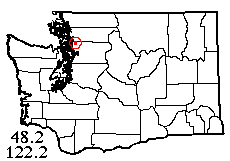 |
![]() 31 III 2017: After nearly 5 months without field work, favorable conditions finally came together for a short excursion to an area in north Snohomish County that should be reachable by bus, but isn't. Laurel (on her way to a hike with partner Marie Rose) dropped me off at the driveway to historic Zion Cemetery near Silvana. In the past, we've never had a problem with public access to cemeteries for spider collecting; but this one was prominently posted "No Trespassing." (I did venture in just far enough for a quick photo of the 1890 "Little White Church"). I'd hoped also to access gravel bars on the adjacent Stillaguamish River, but they were underwater leaving only slick mud banks. But on the plus side, the Pioneer Highway bridge had lots of niches for web-makers and an adjacent forest tract proved accessible, though at only one point (the rest was on the wrong side of a very active stream in Jackson Gulch).
31 III 2017: After nearly 5 months without field work, favorable conditions finally came together for a short excursion to an area in north Snohomish County that should be reachable by bus, but isn't. Laurel (on her way to a hike with partner Marie Rose) dropped me off at the driveway to historic Zion Cemetery near Silvana. In the past, we've never had a problem with public access to cemeteries for spider collecting; but this one was prominently posted "No Trespassing." (I did venture in just far enough for a quick photo of the 1890 "Little White Church"). I'd hoped also to access gravel bars on the adjacent Stillaguamish River, but they were underwater leaving only slick mud banks. But on the plus side, the Pioneer Highway bridge had lots of niches for web-makers and an adjacent forest tract proved accessible, though at only one point (the rest was on the wrong side of a very active stream in Jackson Gulch).
In all, I sampled six microhabitats, only three of those being reasonably productive. First and foremost I spent 2-3 hours sifting the abundant maple litter in the forest tract, "hiding in plain sight" rather close to the highway. Many cars passed, but only one stopped and backed up: "Did I see what I thought I saw?" But they didn't get out and ask silly questions, praise be! The litter got me 10 spider species, plus assorted other creatures. Next I sifted some moss, which was lackluster and added only one species. Fern foliage, however, was rather productive and added six species. On aerial photos this forest tract looked rather extensive, but as I stood at the bottom of the slope I saw a human head drift by (at bicycle speed) right at the top, so evidently there was something private up there. I scouted around for grassy habitats and finally found some decent grass at the edge of a pasture, adding 3 species. Back at the cemetery entrance, foliage of cedar trees added nothing new at all, and none of the wolf spiders in the grass was mature. But the bridge abutments and adjacent structures added 5 more species for a total of 24. The day had been semi-sunny off and on, and cool but not cold. And was it ever nice to be out in the field again! Laurel picked me up right on time to the very minute. Postscript: one week later Laurel picked up pitfall traps I'd set here for her; alas, they contained no spiders!
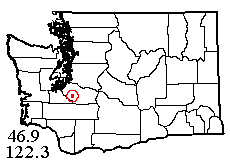 |
![]() 4 IV 2017: In cloudy but dry weather, Laurel and I headed for Rapjohn Lake in southern Pierce County, site of the only public access tract in another "hole" in my collection coverage. The origin of the unique name Rapjohn seems to be lost in the mists of time. Anyway, we arrived in good time and Laurel began tapping Douglas-fir cones (present in some numbers) while I strolled up the access road beating conifer foliage. I happened to meet the man who lived on the south side of the narrow public tract (he was walking his dog) and received permission to collect on the private land on that side; meanwhile, Laurel encountered the north-side neighbor who was similarly friendly, so we had a good tract to collect in. Besides the friendly neighbors, the site was also notably peaceful (on a clear day, we would have had a nice view too). I had soon beat 9 spider species from Douglas-fir and red cedar. Understory (salal, fern and Oregon-grape) added 5-6 more. Meanwhile, Laurel had added 2 more species from fir cones and 3 more from the public outhouse and other buildings.
4 IV 2017: In cloudy but dry weather, Laurel and I headed for Rapjohn Lake in southern Pierce County, site of the only public access tract in another "hole" in my collection coverage. The origin of the unique name Rapjohn seems to be lost in the mists of time. Anyway, we arrived in good time and Laurel began tapping Douglas-fir cones (present in some numbers) while I strolled up the access road beating conifer foliage. I happened to meet the man who lived on the south side of the narrow public tract (he was walking his dog) and received permission to collect on the private land on that side; meanwhile, Laurel encountered the north-side neighbor who was similarly friendly, so we had a good tract to collect in. Besides the friendly neighbors, the site was also notably peaceful (on a clear day, we would have had a nice view too). I had soon beat 9 spider species from Douglas-fir and red cedar. Understory (salal, fern and Oregon-grape) added 5-6 more. Meanwhile, Laurel had added 2 more species from fir cones and 3 more from the public outhouse and other buildings.
I spent the bulk of the afternoon sifting. First, there was a nice deposit of litter under planted poplar trees beside the parking area. Nasty blackberry intertwined the area and I didn't get my litter sample without scratches, but 7 spider species resulted, including a Scotinella I don't recognize at all! Next, I sifted a bed of moss behind some horsetails in the lakeside marsh. It wasn't a bog (the moss was growing on soil) but very productive, adding 6 species. Finally, maple litter on the neighbor's land was only moderately productive, adding 3 species not taken otherwise. Finally, with the dew off the grass, Laurel and I swept the marshy lakeside meadows, adding 8 species; the best catch (in Laurel's sweep) was a Glyphesis microspider, previously taken only once at a lake about 1 mile to the southwest of Rapjohn! We were just getting ready to head for home when the first raindrops fell. On the way, we stopped at my 2014 Seeley Lake site to set some pitfalls for Laurel's crab spider project (result, one spider, no crab spiders). Total catch from Rapjohn Lake, a very nice 39-43 species.
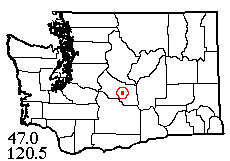 |
![]() 21 IV 2017: On possibly the loveliest day so far this spring, Laurel and I headed across the pass to pick up an undersampled area just off the I-90 freeway near Ellensburg. Available tracts here included a large field belonging to the county, a dense belt of cottonwood along the Yakima River, a pine stand along a retention pond on the freeway side of the river — and the local HQ of the Washington State Patrol! I started off to sweep the county field. Since last year much of it had been taken over for gravel storage, but there was still enough field for a sweep sample, not very diverse but including an uncommon microspider. A pile of large cobbles had 2 good species active in the sun but few spiders under the rocks, where instead I found 2 blue-tailed skinks! Across the road, the police had planted some young pines whose foliage added 2 more species; later, Laurel tapped pine cones here getting 2 species she hadn't taken at her first cone site near the freeway, which was exceptionally productive getting 9 species and more than 1.5 individual spiders per cone (see her account).
21 IV 2017: On possibly the loveliest day so far this spring, Laurel and I headed across the pass to pick up an undersampled area just off the I-90 freeway near Ellensburg. Available tracts here included a large field belonging to the county, a dense belt of cottonwood along the Yakima River, a pine stand along a retention pond on the freeway side of the river — and the local HQ of the Washington State Patrol! I started off to sweep the county field. Since last year much of it had been taken over for gravel storage, but there was still enough field for a sweep sample, not very diverse but including an uncommon microspider. A pile of large cobbles had 2 good species active in the sun but few spiders under the rocks, where instead I found 2 blue-tailed skinks! Across the road, the police had planted some young pines whose foliage added 2 more species; later, Laurel tapped pine cones here getting 2 species she hadn't taken at her first cone site near the freeway, which was exceptionally productive getting 9 species and more than 1.5 individual spiders per cone (see her account).
I expected to get a good sample sifting cottonwood litter by the river, and I wasn't disappointed. I probably spent 3 hours sifting, getting litter from slopes, flats, and perched on stumps and tree boles. Just about the time Laurel joined me after her first pine site, I discovered I didn't have the vial containing my first 2 hours' sift sample. I knew it couldn't be more than a few feet away, but we spent around 15 minutes searching without result. Finally I found it inside the bag of not-yet-sifted litter! The full litter sample had 11 spider species and assorted other good things. The most remarkable, though, was a male of the common telemid Usofila pacifica; I've seen hundreds of females of this spider (possibly parthenogenic) but this is only my second male! Laurel had also taken much better under-rock spiders at her site than I had in my rockpile. Having a nice sample of 32-34 good species, we headed for our customary Mountain High burgers, then home.
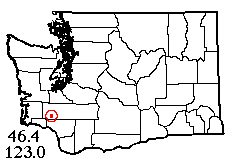 |
![]() 29 IV 2017: Hooray, Jerry Austin finally managed to connect with another field trip! Laurel, Jerry and I headed south on this mostly-cloudy day because that was where the least rain chance was, "only" 20%. After some discussion, we picked a trip plan near the Lewis County town of Vader (my father's birthplace, as it happens), at the edge of the Willapa Hills. Parking outside the gate of a tree farm that allows recreational access, I collected mostly in the rich, natural riparian zone of Brim Creek. Fern understory gave me at least 10 species (other understory types were less productive). Moss on trees added 4 and alder-maple litter added 6 more. Meanwhile, Jerry and Laurel had added 5 more species from various habitats including the gate we'd parked behind. An adjacent clearcut, probably no more than 2 years old, had lots of Pardosa vancouveri wolf spiders, 3 more species that I swept from grass and 2 more that Laurel found under roadside stones.
29 IV 2017: Hooray, Jerry Austin finally managed to connect with another field trip! Laurel, Jerry and I headed south on this mostly-cloudy day because that was where the least rain chance was, "only" 20%. After some discussion, we picked a trip plan near the Lewis County town of Vader (my father's birthplace, as it happens), at the edge of the Willapa Hills. Parking outside the gate of a tree farm that allows recreational access, I collected mostly in the rich, natural riparian zone of Brim Creek. Fern understory gave me at least 10 species (other understory types were less productive). Moss on trees added 4 and alder-maple litter added 6 more. Meanwhile, Jerry and Laurel had added 5 more species from various habitats including the gate we'd parked behind. An adjacent clearcut, probably no more than 2 years old, had lots of Pardosa vancouveri wolf spiders, 3 more species that I swept from grass and 2 more that Laurel found under roadside stones.
While I did my riparian sampling and Jerry wandered about doing his own thing, Laurel hiked a half-mile north to an older clearing shown on the topo map. It was probably an old farm or orchard, since it features a number of very ancient, not-quite-dead apple trees. Here she sampled moss and lichen on cascara buckthorn branches, Douglas-fir foliage (finally found some here, the trees elsewhere had no low branches), ground active spiders and the adjacent forest understory, adding 9 more species for a fine total of 42. We had considered moving to a nearby area after finishing at Brim Creek, but intermittent sprinkles through the afternoon were harbingers of the coming downpour, so we contented ourselves with having nailed our main goal.
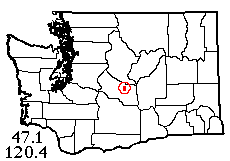 |
![]() 3 V 2017: On another trip with Laurel to pine cone country, we zigzagged through the rectilinear road network NE of Ellensburg to the end of a county road at the crossing of Naneum Creek. The main place to park was a school bus turnaround; fortunately, no school bus ever showed up although it was a school day. Partly-cloudy skies gradually cleared for a pleasantly warm afternoon. This time I started by sifting cottonwood litter, finding the spiders sparse but very good with 11 species, three of them uncommon and one decidedly rare, an undescribed Orchestina (Oonopidae) that I got both sexes of. An irrigation canal branches off the creek at this point but fortunately we could cross it on a culvert; one of Laurel's pine trees was on the other side, adding 4 species from the cones. I added 2 from pine foliage and Laurel got 2 others from understory and antelope brush. Her second pine cone sample, from roadside trees, added 3 more species including the newly introduced zodariid, Zodarion rubidum, which seems to be extending its range very rapidly! She also added 5 more from the bridge railings.
3 V 2017: On another trip with Laurel to pine cone country, we zigzagged through the rectilinear road network NE of Ellensburg to the end of a county road at the crossing of Naneum Creek. The main place to park was a school bus turnaround; fortunately, no school bus ever showed up although it was a school day. Partly-cloudy skies gradually cleared for a pleasantly warm afternoon. This time I started by sifting cottonwood litter, finding the spiders sparse but very good with 11 species, three of them uncommon and one decidedly rare, an undescribed Orchestina (Oonopidae) that I got both sexes of. An irrigation canal branches off the creek at this point but fortunately we could cross it on a culvert; one of Laurel's pine trees was on the other side, adding 4 species from the cones. I added 2 from pine foliage and Laurel got 2 others from understory and antelope brush. Her second pine cone sample, from roadside trees, added 3 more species including the newly introduced zodariid, Zodarion rubidum, which seems to be extending its range very rapidly! She also added 5 more from the bridge railings.
260 meters north of us (up a gated road into Ellensburg city property) was an isolated, tall Douglas-fir tree, and I next worked my way up to it sweeping the Juncus, grass and dandelions of a very extensive, lush riparian meadow. The sweep sample added 5 species, but once I got to the tree, pickings there were slim, with one additional species under rocks, nothing new from tree foliage nor Douglas-fir cones that I talked Laurel into sampling, and only a "house pseudoscorpion" in a promising-looking barn. It was certainly a beautiful, peaceful spot though. Laurel and I each found one (different) wolf spider species beside the creek. In all, we collected 36 species here, all different from an old 3-species sample taken nearby. On the way, we had also stopped at Indian John Rest Area along I-90 to sample pine cones there; among others, this produced yet another Orchestina! After a day of hard, productive work we fully deserved our customary burgers.
 |
![]() 9 V 2017: It was a field trip with Laurel Ramseyer for the 4th week in a row! On this sunny, if somewhat hazy, day we selected a Puget Sound destination, Hartstene (a.k.a. Harstine) Island, on the far side of the Key Peninsula from Tacoma. About half as big as the well-known Vashon Island (with 1/10 the population), and reached by a bridge, Hartstene is so obscure that no one I told about our trip had ever heard of it. About half the island is accessible timberland, so collecting habitats were easy to find; our first stop was so productive we saved the others for another day. First, a roadside sweep got me 5 species in a few minutes. Laurel, on this same roadside, turned over boards and bark chunks, getting two Callobius species, one of them uncommon, and tapped 100 Douglas-fir cones adding 4 species not otherwise taken. I crossed a 5-year-old clearcut, where wolf spiders were running, and spent some time in an alder grove that had a very diverse understory (from which I beat 12 species); I also got decent leaf litter and moss samples.
9 V 2017: It was a field trip with Laurel Ramseyer for the 4th week in a row! On this sunny, if somewhat hazy, day we selected a Puget Sound destination, Hartstene (a.k.a. Harstine) Island, on the far side of the Key Peninsula from Tacoma. About half as big as the well-known Vashon Island (with 1/10 the population), and reached by a bridge, Hartstene is so obscure that no one I told about our trip had ever heard of it. About half the island is accessible timberland, so collecting habitats were easy to find; our first stop was so productive we saved the others for another day. First, a roadside sweep got me 5 species in a few minutes. Laurel, on this same roadside, turned over boards and bark chunks, getting two Callobius species, one of them uncommon, and tapped 100 Douglas-fir cones adding 4 species not otherwise taken. I crossed a 5-year-old clearcut, where wolf spiders were running, and spent some time in an alder grove that had a very diverse understory (from which I beat 12 species); I also got decent leaf litter and moss samples.
Back across the clearcut (recently planted with red cedar), I was beating conifer foliage (13 species) when Laurel rejoined me, beating salal foliage for 12 species. Both of us got nice adult specimens of the tiny Trogloneta in our shrub beats. The vegetation produced 5 jumping spider species. Laurel also added the flat crab spider Bassaniana utahensis from under the bark of a standing dead tree, making 44 species in all from Hartstene Island where none were known before.
To conclude our day, we stopped at the landward end of the island bridge in Latimer's Landing County Park. Here, Laurel found adult Zygiella x-notata orbweavers on the dock while I checked out the beach and consolidated-till bluff. Various spiders had webs in small erosion pockets in the bluff face, including adult Calymmaria, juvenile "American house spiders," and a small, possibly introduced theridiid (Achaearanea or related) that I don't recognize at all, possibly the most interesting spider of the trip.
 |
![]() 19 V 2017: Back to pine country, actually a bit east of pine country, but our destination (a recreation area, once private, now owned by Grant Public Utilities) clearly had many planted trees in the steppe surroundings, and I hoped there would be pines. There were, just two! Leaving Laurel tapping Ponderosa pine cones, I headed up the artificial "cove" (flooded by Wanapum Dam) to riparian habitats at the head, around the mouth of Johnson Creek. Here I swept numerous spiders from tall riparian meadows; alas, a lot turned out to be juvenile even this late in the season, but I did get 8 species. Sifting litter of non-native elms and maples got me just one species, Phrurotimpus borealis. Across the creek at the south canyon wall, I added 4 species from sagebrush and rabbitbrush. At this point Laurel rejoined me, having taken a super-rich sample from the parking lot pine cones — but the vial didn't seem to be in her pocket! (She later found it in the car). As she headed up the south side of the cove to visit the second pine tree, a non-native black pine by the main road, I began turning over rocks.
19 V 2017: Back to pine country, actually a bit east of pine country, but our destination (a recreation area, once private, now owned by Grant Public Utilities) clearly had many planted trees in the steppe surroundings, and I hoped there would be pines. There were, just two! Leaving Laurel tapping Ponderosa pine cones, I headed up the artificial "cove" (flooded by Wanapum Dam) to riparian habitats at the head, around the mouth of Johnson Creek. Here I swept numerous spiders from tall riparian meadows; alas, a lot turned out to be juvenile even this late in the season, but I did get 8 species. Sifting litter of non-native elms and maples got me just one species, Phrurotimpus borealis. Across the creek at the south canyon wall, I added 4 species from sagebrush and rabbitbrush. At this point Laurel rejoined me, having taken a super-rich sample from the parking lot pine cones — but the vial didn't seem to be in her pocket! (She later found it in the car). As she headed up the south side of the cove to visit the second pine tree, a non-native black pine by the main road, I began turning over rocks.
Having taken a few decent under-rock spiders and the common scorpion of the area, Paruroctonus boreus, I turned over my next rock, then set a personal record for standing backward broad jump. There was an unexpected rattlesnake, first I've ever found under rocks! Back at the parking lot, I beat planted spruce trees while waiting for Laurel; on her return, she sampled pine foliage and we were about ready to go. The best specimens were an unfamiliar male Dictyna from the black-pine cones and an unfamiliar Sitticus jumping spider from the outhouse. In all, even counting 4 old prior records, we only brought this area up to 25 species. I'm glad we decided against hiking westward into more natural, drier habitats; based on how we did in this lush riparian zone, we probably would have taken less than 20 species to the west.
 |
![]() 25 V 2017: Today, I hoped to bag two areas in western Skagit County that both had some prior spider records. First, a short stop at Edgewater Park along the Skagit River in the city of Mount Vernon. Due to a wrong turn, we ended up at the park boat launch rather than the natural area I was aiming for. Can't complain though, Laurel found a non-native black pine tree and tapped 40 pine cones, adding a species, and I added 7 more species from Douglas-fir foliage plus another from understory by the river. A last stop (the park restroom) brought the area sample from 19 to 28 species.
25 V 2017: Today, I hoped to bag two areas in western Skagit County that both had some prior spider records. First, a short stop at Edgewater Park along the Skagit River in the city of Mount Vernon. Due to a wrong turn, we ended up at the park boat launch rather than the natural area I was aiming for. Can't complain though, Laurel found a non-native black pine tree and tapped 40 pine cones, adding a species, and I added 7 more species from Douglas-fir foliage plus another from understory by the river. A last stop (the park restroom) brought the area sample from 19 to 28 species.
For some time, I'd wanted to collect at the Skagit Land Trust's Minkler Lake Preserve, east of Sedro Woolley. It appeared that the best access would be via the Cascade Trail, a county rail-trail that runs along the south edge of the preserve. We parked where the trail crosses Hoehn Road and began hiking, as I swept trailside grass, getting 4 species. On the way, we passed a nonchalant-appearing killdeer that was nesting right beside the trail! Just passing out of farmland, we paused at the trail bridge over Wiseman Creek; Laurel took 7 species from this and a subsequent bridge, including 2 interesting range extensions for introduced spiders. Now we were at the edge of the preserve land. But this stretch of the preserve is mainly a trail-free alder swamp, moreover with plenty of horrid Himalayan blackberry. We got perhaps 50 meters into the preserve along a drainage channel at one point, but mostly had to collect along the trail right-of-way. This involved much beating of shrub understory (for 8 spider species and one introduced harvestman). At one point there were 3 trailside maple trees; two of these had decent leaf litter that added 6 spider species and assorted other things (the third tree had ants in the litter). Moss added three more species.
We still needed a spot with conifer cones for Laurel to tap (the only 2 fir trees along the trail were surrounded by swamp water), so we hiked back to the car (the killdeer was still there) and headed north to the intersection of Minkler Road, where some people had a nice grove of fir trees in their yard. But the lawn was too neat, no cones! West toward the actual lake, we passed a short tract of Preserve land fronting on the road and this looked promising, lots of planted young conifers (Douglas-firs, spruces and a pine). Cones were in short supply there too but Laurel found plenty on the roadside across the way, adding a species. Meanwhile I hit the jackpot with conifer foliage that had 8 good species, making 33 (36 with old records). The arachno-fauna of this area has a high proportion of introduced species, and what little we could see of the Minkler Preserve is well-stocked with invasive plants, but I understand restoration efforts are in progress. Good luck to the restorers!
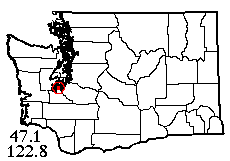 |
![]() 3 VI 2017: On new volunteer Chris Smitelli's first field trip, I hoped to collect near South Prairie Creek in an obscure corner of national forest northwest of Mt. Rainier. On the way there we passed some people doing an organized "run" — right along the state highway! Arrived at Wilkeson, some misty drizzle spattered the windshield, despite a dry weather forecast. But we forged on up an increasingly pothole-filled road. Finally, within a mile or two of our goal, we had to admit it was actually raining, the road and foliage were soaked, and collecting prospects dim. Hoping for drier conditions, we turned around and headed for an alternate, lowland goal.
3 VI 2017: On new volunteer Chris Smitelli's first field trip, I hoped to collect near South Prairie Creek in an obscure corner of national forest northwest of Mt. Rainier. On the way there we passed some people doing an organized "run" — right along the state highway! Arrived at Wilkeson, some misty drizzle spattered the windshield, despite a dry weather forecast. But we forged on up an increasingly pothole-filled road. Finally, within a mile or two of our goal, we had to admit it was actually raining, the road and foliage were soaked, and collecting prospects dim. Hoping for drier conditions, we turned around and headed for an alternate, lowland goal.
Without further problems, we arrived at the Chehalis-Western Trail (a former railroad) about a mile south of Woodard Bay north of Olympia, before 1 pm. Weather was still mostly cloudy, but dry. The roadside where we parked had lush grassy verge (with buttercups) on both sides, so we began by sweeping. Good choice; over a hundred meters or so of roadside we swept no less than 13 species, including some non-natives but also the rare native Cyclosa turbinata (see album). An adjacent, accessible woodland tract had a giant maple tree, three giant red cedars and partly-nettle, partly-fern understory. We added 7 species from maple litter, 2 more from moss on the trunk, and 8 more from the understory, while people passing on the adjacent trail couldn't detect us due to a tall blackberry thicket between. An aerial web in the woods gave us the other local Cyclosa, C. conica.
Next we hiked south on the actual trail from our access point at 56th Avenue. Very peaceful rural surroundings with farms and no traffic noise, but invasive blackberry mostly blocked us from any habitat, particularly conifer foliage of which we managed to beat only a few boughs. By this time the clouds had parted letting sunlight through, but we never found any wolf spiders. So back to 56th, and northward where it was a very different story, much less blackberry and trailsides featuring native plants like salal, Oregon-grape and thimbleberry. The salal alone added 5 more species. A little farther north there was enough western hemlock foliage to beat that we added 4 more species. Reaching the trail's end at Woodard Bay, we turned around and on the way back, spotted some lush siftable moss; however, this had no species we hadn't taken from the moss on the big maple, and besides the mosquitos from an adjacent wetland were starting to swarm! Heading for home, we had a fine sample of 40 species despite the late start due to weather failure.
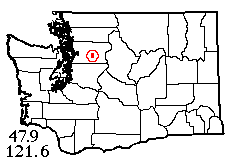 |
![]() 7 VI 2017: On my second field trip with Chris Smitelli, we drove 13 miles up Sultan Basin Road (off Stevens Pass Highway), which I had believed was gated long before that point. In fact, it was paved most of the way! After we crossed the 121.7 grid line, the road just kept going, so we continued even beyond the maps I brought, all the way to a parking lot at Olney Pass (where waters drain SW to Olney Creek and NE to Spada Lake in the Everett city watershed). In the hazy sunlight, a green field right beside the parking lot was swarming with spiders: two Pardosa species and two crab spiders on the move, and 11 others to be swept from grass and buttercups. Next we moved to an adjacent alder grove where a spring fed a little brook. We didn't know it, but a short walk down this brook would have brought us to the lake! Unfortunately there was practically no alder leaf litter in the grove. However, Chris got big wads of moss (rather dusty from the adjacent road) off the trees. Plenty of spiders but only 3 species (mainly Ethobuella tuonops) in the moss.
7 VI 2017: On my second field trip with Chris Smitelli, we drove 13 miles up Sultan Basin Road (off Stevens Pass Highway), which I had believed was gated long before that point. In fact, it was paved most of the way! After we crossed the 121.7 grid line, the road just kept going, so we continued even beyond the maps I brought, all the way to a parking lot at Olney Pass (where waters drain SW to Olney Creek and NE to Spada Lake in the Everett city watershed). In the hazy sunlight, a green field right beside the parking lot was swarming with spiders: two Pardosa species and two crab spiders on the move, and 11 others to be swept from grass and buttercups. Next we moved to an adjacent alder grove where a spring fed a little brook. We didn't know it, but a short walk down this brook would have brought us to the lake! Unfortunately there was practically no alder leaf litter in the grove. However, Chris got big wads of moss (rather dusty from the adjacent road) off the trees. Plenty of spiders but only 3 species (mainly Ethobuella tuonops) in the moss.
Walking back westward along the road, I checked out other alder stands: still no litter! Driving in, we had glimpsed marshy meadows beside the Olney Pass pond, but they were too difficult to reach down a very steep, brush-covered bank. A pair of large herons found access easy: they can fly! Soon we reached our planned second collecting site, a side road leading to a new (no more than a year old) clearcut where I'd glimpsed lots of conifer foliage while driving in. Here we finally found some leaf litter, alder mixed with hemlock needles, in a roadside stand. It added 3 spider species.
The clearcut conifer foliage was a disappointment; most of it was unreachable, at the top of another steep bank. What we did reach gave us 9 species, 4 of them adding to the list. In the clearcut itself, just as I'd hoped, we each found one jumping spider species active on a log. Mine was the bizarre-looking "Popeye spider," Habronattus oregonensis. There were plenty of wolf spiders here too, as far as I could tell the same two Pardosa species we found in the meadow. In an adjacent mid-aged western hemlock stand, we swept understory and sampled aerial webs, adding 3 more species to the list. Then I noticed that some old, giant stumps and snags from the original logging were scattered about. We were at only 2000 feet elevation here, lower than the best dead-wood collecting, but I decided to try it. For this elevation, it wasn't bad at all, adding 5 species including several Bathyphantes keenii, plus some great native ethopolid centipedes. Finally, we continued down the slope to the cool ravine bottom where the headwaters creek draining the pass pond ran through lush riparian shrubs and herbs. Sweeping here gave us two additional species. In all, we took a solid sample of 36 spider species, mostly native, and access was amazingly easy.
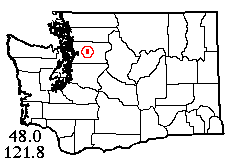 |
![]() 23 VI 2017: After a 2-week gap (caused by weather, absent volunteers and other problems), I finally realized my plan of collecting in montane forest halfway up Mt. Pilchuck, a well-known Snohomish County peak. Jerry Austin drove, and we reached our destination, a pair of old forest rock quarries, without incident. Target-shooters occupied the first quarry (it later turned out to be too hot and dry anyway), so we proceeded to the second. This one is partly overgrown with alder and seems to have permanent seeps of water, making apparently long-term puddles in the old road (with extensive aquatic insect faunas) and even an amazing little pocket Sphagnum bog back in the quarry. The only fly in the ointment was a population of beautiful but bloodthirsty medium-big deer flies, similar to the album image.
23 VI 2017: After a 2-week gap (caused by weather, absent volunteers and other problems), I finally realized my plan of collecting in montane forest halfway up Mt. Pilchuck, a well-known Snohomish County peak. Jerry Austin drove, and we reached our destination, a pair of old forest rock quarries, without incident. Target-shooters occupied the first quarry (it later turned out to be too hot and dry anyway), so we proceeded to the second. This one is partly overgrown with alder and seems to have permanent seeps of water, making apparently long-term puddles in the old road (with extensive aquatic insect faunas) and even an amazing little pocket Sphagnum bog back in the quarry. The only fly in the ointment was a population of beautiful but bloodthirsty medium-big deer flies, similar to the album image.
Jerry collected two wolf spider species but didn't find any ground-active jumping spiders. All the conifer foliage was western hemlock, producing 8-9 species. The roadside understory had these same species, dominated by water-loving Tetragnatha versicolor. The pocket bog in the quarry, obviously not very old, yielded 3 species to sifting, none of them bog-specific but all adding to the sample. I managed to scrape together one bag of alder litter from an adjacent grove, and it added 4 more species, all different. Jerry found Zelotes fratris under a rock, and half-an-hour's dead-wood tapping in the adjacent forest produced only two identifiable species. Thankfully, no deer flies in the forest shade! Up to this point, we had only 20 species for the site.
I had hoped to find maple litter and a sweeping site up a second side road that led across Rotary Creek to an old clearcut. What side road? For the first 100 feet, the blocked side road appeared to be walkable as a trail, but then the "trail" vanished in impenetrable brush! So, we drove on up the main Mt. Pilchuck road looking for habitats. In 1.3 miles, there was enough grassy roadside verge to get a sweep sample, and this added (I thought) 7 species; in reality only 4. Meanwhile, Jerry found an area of very productive rocks, mostly duplicating species taken at the quarry but adding a Tarentula kochii with a nice big egg sac. Armed with at least 25 species (and 2 more for the area in an older collection), we descended the mountain, still not finding any good maple trees but stopping at scenic Hawthorn Creek for a photo op and near the Heather Lake trailhead for a ripe salmonberry snack.
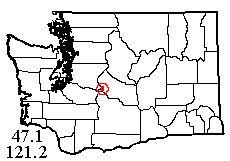 |
![]() 27 VI 2017: Laurel, back from Europe and restored to health, was ready for an easy field day in the shade. I planned a site in the heart of the Cascades, about 4 miles SSW of Easton. The day was sunny and not too hot; the forest road wasn't too bad but featured a couple of exciting encounters with loaded log trucks. Our side road crossing Cole Creek had water bars just a little too deep for our town car, but it was just a short walk to my riparian habitat. Laurel said she'd found a white pine tree a short way beyond the creek, then vanished in that direction to tap pine cones.
27 VI 2017: Laurel, back from Europe and restored to health, was ready for an easy field day in the shade. I planned a site in the heart of the Cascades, about 4 miles SSW of Easton. The day was sunny and not too hot; the forest road wasn't too bad but featured a couple of exciting encounters with loaded log trucks. Our side road crossing Cole Creek had water bars just a little too deep for our town car, but it was just a short walk to my riparian habitat. Laurel said she'd found a white pine tree a short way beyond the creek, then vanished in that direction to tap pine cones.
My first stop was a small roadside field/meadow, where I quickly spotted 2 active wolf spiders: 2 different species! Sweeping here and along the roadside got me 7 more species. After beating a bunch of conifer foliage, both along the road and in little glades upslope, I already had 19 species, including some very unusual linyphiids. Next I squeezed into the very dense tangle of creekside alder and willow (with a few tall cottonwoods emerging) to sift litter. Here I saw the day's only mosquitos, too few to annoy me, and added 5 more spider species besides other good stuff. Tapping dead wood, and a riparian understory sweep, added only one more species. A short distance downstream, the map showed a waterfall, but dense thickets barred the way. Now it was 4:30 PM and I decided to get together with Laurel to discuss a possible second site. And couldn't find her!
The road forked in the direction she'd been going. The lower fork quickly became overgrown, so I decided she couldn't have gone that way. Asking a man with a dog who'd just parked beside the creek to tell her if he saw her, I set off on the upper fork which led to a small lake she'd been interested in, yelling at intervals. About a mile later, I reached the lake: an attractive spot, with pine cones nearby, but no Laurel! By this point I was really getting concerned, so without pausing to collect, I headed back for the car, intending to leave a note and hike toward town until I was able to call for help. Thankfully, Laurel was waiting at the car, having walked a mile and a half up the wrong road (only overgrown for a short distance), through a complex network of logging roads and trails to a viewpoint where she found a second pine tree. I can't really blame her for the wrong turn since I had the map! In all, pine cones in the Cole Creek area added 7 more spider species (some good ones, too) giving us 34 for the day. Back on Easton's main street, a deposit of Ponderosa cones added nothing, but we finished the day with satisfactory burgers and shakes.
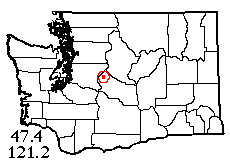 |
![]() 2 VII 2017: Just a few days later, Laurel was ready for another venture to the east slope of the Cascades in search of more pine cones. Not so lucky on the pine cones this time, but otherwise we got a fine sample. Heading up the Cle Elum River toward Salmon La Sac, we turned onto the Cooper River Road and continued right up to Cooper Pass (3400' elev.), on the divide between the Cle Elum and Kachess rivers. In a meadow a quarter-mile north of the pass, I had an 11-species sweep sample in about an hour; meanwhile, Laurel had been beating conifer foliage, taking 14 species (8 of them different from my swept spiders, including vanishingly rare Theridion michelbacheri). Add two wolf spider species and we already had our minimum sample! Meanwhile, Laurel had been tapping 100 Douglas-fir cones, taking only 3 species; but the 17 pine cones that were all she could find here gave her only one juvenile wolf spider, oh well. I sifted another 4 species from litter beside a mosquito-breeding marsh, and Laurel beat 2 different species of flower crab spiders from Ceanothus; a male promptly climbed onto the wrong female inside her vial, oops!
2 VII 2017: Just a few days later, Laurel was ready for another venture to the east slope of the Cascades in search of more pine cones. Not so lucky on the pine cones this time, but otherwise we got a fine sample. Heading up the Cle Elum River toward Salmon La Sac, we turned onto the Cooper River Road and continued right up to Cooper Pass (3400' elev.), on the divide between the Cle Elum and Kachess rivers. In a meadow a quarter-mile north of the pass, I had an 11-species sweep sample in about an hour; meanwhile, Laurel had been beating conifer foliage, taking 14 species (8 of them different from my swept spiders, including vanishingly rare Theridion michelbacheri). Add two wolf spider species and we already had our minimum sample! Meanwhile, Laurel had been tapping 100 Douglas-fir cones, taking only 3 species; but the 17 pine cones that were all she could find here gave her only one juvenile wolf spider, oh well. I sifted another 4 species from litter beside a mosquito-breeding marsh, and Laurel beat 2 different species of flower crab spiders from Ceanothus; a male promptly climbed onto the wrong female inside her vial, oops!
For a second stop, we continued westward and parked at the first accessible point on the Kachess River, which here is no bigger than a creek. While Laurel found a photogenic tailed frog, I swept 4 species from the streamside understory. In an unofficial campsite here was an elaborate stone oven, from which Laurel took 2 more species.
Not that far downstream at the Mineral Creek trailhead, the stream had now (having taken 2 tributaries) become a full-fledged river, with a floodplain alder forest. Here, I was able to spend half an hour sifting much better-developed leaf litter, adding 4 more species. Adding 3 more Laurel found under stream cobbles, we now had a total of 37, including some very nice records indeed. An attempt to reach a nearby summit for a final site petered out when the road did, but we got some great views of adjacent peaks. Homeward bound, it was once more time for dinner at Mountain High Hamburgers.
 |
![]() 12 VII 2017: With habitats rapidly drying in rainless weather, we decided to say farewell to east-slope Cascades pine forest with one last trip. Well, can't win them all. We reached Ruby Creek Road on the north side of Blewett Pass (a checkerboard of private and Forest Service land), and after passing some confusing warning signs about a Weyerhaeuser harvest operation near the highway, we made our way up deteriorating roads to the northwest crest of Tronsen Ridge (3680' elevation). Here, in over an hour I managed to sweep and beat all of 3 spider species from vegetation, while Laurel found nothing but juveniles in pine and Douglas-fir cones. Two minds with a single thought: let's head back to that lush habitat we spotted near Ruby Creek!
12 VII 2017: With habitats rapidly drying in rainless weather, we decided to say farewell to east-slope Cascades pine forest with one last trip. Well, can't win them all. We reached Ruby Creek Road on the north side of Blewett Pass (a checkerboard of private and Forest Service land), and after passing some confusing warning signs about a Weyerhaeuser harvest operation near the highway, we made our way up deteriorating roads to the northwest crest of Tronsen Ridge (3680' elevation). Here, in over an hour I managed to sweep and beat all of 3 spider species from vegetation, while Laurel found nothing but juveniles in pine and Douglas-fir cones. Two minds with a single thought: let's head back to that lush habitat we spotted near Ruby Creek!
Down in the lush habitat, there was tall roadside verge foliage to sweep, producing in all 10 species — including all those taken on the ridge crest. The riparian forest was bigleaf maple (not the cottonwood more usual in this area), but leaf litter by the road was bone-dry and spiderless. Down by the trickle stream, I was surprised to find a breath of cool air coming out of the stream culvert, which simply passes through to the uphill side of the road. A couple of bags of moist litter scraped together next to the water actually added 3 more species. Both of us tried sweeping apparently lush understory, adding a further 3 species. Conifer beating added nothing. Laurel's tapping of 100 pine cones in 2 different habitats, again gave her only juveniles. She did manage to catch one of the elusive Agelenopsis funnel weavers whose webs were everywhere, and I'm trying to rear it for an ID. It leaves us with 16 or 17 species from here. Fortunately, it's close to the highway and it will be easy to revisit in a better season. One nice thing, we had outstanding peace and solitude all day.
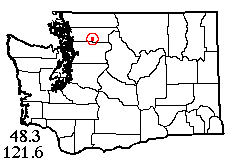 |
![]() 18 VII 2017: After last week's experience, we knew we needed moist western-Washington sites, preferably at higher elevations. For our mid-July trip, we selected North Mountain Lookout near Darrington, which involves a gentle one-mile hike up a gated road to a fire lookout tower, now being renovated, at 3824' elevation. What it also involved, though, was a long drive on a confusing network of wholly unmarked back roads! After the first couple of miles, I lost confidence in my map's matching the road we were on. We backtracked to where a road crew was working. They knew nothing. So all the way back to the Darrington Ranger Station, where we got 2 opposite opinions from 2 staff as to the correct route. The one we tried first was the wrong one. All this wasted a bit over an hour, but we did eventually arrive at the gate and had no further problems.
18 VII 2017: After last week's experience, we knew we needed moist western-Washington sites, preferably at higher elevations. For our mid-July trip, we selected North Mountain Lookout near Darrington, which involves a gentle one-mile hike up a gated road to a fire lookout tower, now being renovated, at 3824' elevation. What it also involved, though, was a long drive on a confusing network of wholly unmarked back roads! After the first couple of miles, I lost confidence in my map's matching the road we were on. We backtracked to where a road crew was working. They knew nothing. So all the way back to the Darrington Ranger Station, where we got 2 opposite opinions from 2 staff as to the correct route. The one we tried first was the wrong one. All this wasted a bit over an hour, but we did eventually arrive at the gate and had no further problems.
A surprising variety of butterflies (we must have seen 10 species) rendered the hike up the road interesting. Well warmed-up, we arrived at the lookout together with 2 young fellows who didn't stay long; once they left, we were alone on North Mountain. Sweeping around the tower got me 7 species, and conifer foliage added 7 more. Meanwhile, Laurel had tapped her 50 Douglas-fir cones and got no spiders at all! But she made up for it by finding Salticus scenicus on the tower and two more species under boards at the base, including our best find, gnaphosid Orodrassus canadensis. She also caught the day's only wolf spiders, under roadside rocks.
Hiking back to the car, I took a roadside verge transect sweep, adding 2 species while Laurel spotted some folded-leaf retreats of Clubiona pacifica. On our way down the mountain, we stopped at 2 promising sites I'd spotted on the way up. One, a closed-canopy conifer forest with lots of dead wood, kept me busy tapping wood chunks that were rich with spiders — unfortunately, not very mature or diverse, but I thought it was good at the time. While I was doing this, Laurel found 100 Douglas-fir cones that actually had some spiders in them, though again, not very diverse. Finally we stopped in a maple grove at the bottom of the mountain, where I sifted some moss adding 3-4 more species, for a day's total of 25-26. Not outstanding, but satisfactory. For our post-collecting break we tried out the Burger Barn in Darrington; their burgers and fries are very generous.
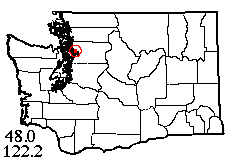 |
![]() 21 VII 2017: For years, my friend Della Scott and I have talked about visiting Jetty Island, a unique place in the Everett (Washington) city harbor that started as a rock jetty and became a sandy island with harbor dredgings and natural accretion. Today it has a quasi-natural sandy beach and dune vegetation, with interesting fauna. A free ferry abets recreation on the island only in summer; if I'd wanted a full sample of the island's spiders I should have visited in late May, but I thought it would do no harm to see what was here on our partly-tourist, partly-scientific visit.
21 VII 2017: For years, my friend Della Scott and I have talked about visiting Jetty Island, a unique place in the Everett (Washington) city harbor that started as a rock jetty and became a sandy island with harbor dredgings and natural accretion. Today it has a quasi-natural sandy beach and dune vegetation, with interesting fauna. A free ferry abets recreation on the island only in summer; if I'd wanted a full sample of the island's spiders I should have visited in late May, but I thought it would do no harm to see what was here on our partly-tourist, partly-scientific visit.
On arrival I asked the visitor staff at the dock how to get to the north end of the island, and they misled me (maybe unintentionally) with directions that took us to a spit enclosing the island's central lagoon, only about halfway to the north end. It's just as well; walking in the loose sand as far as I originally hoped to go would have consumed too much of our 3-hour time on the island. Leaving Della on a swimming beach, I proceeded to a pleasantly natural spot on the lagoon shore. Predictably, sweeping the beach meadow produced only sparse spiders, but by persistence I eventually accumulated 5 species. After checking back in with Della, I returned for driftwood turning (got one Zelotes fratris) and broom beating which added both Enoplognatha ovata and E. latimana, plus a curious juvenile orbweaver that I hope to ID at least tentatively on further study. In all, I added at least 8 species to a sample of forest spiders from my trip in 2007 on the north side of this bay. A pleasant day, and the partly-cloudy skies even kept the sun off us!
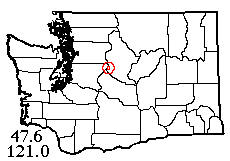 |
![]() 23 VII 2017: For my main field trip this week, and the first with new volunteer Fiona Rhodes, I chose a stiff mountain hike to subalpine Hope Lake near Stevens Pass. The 4400-foot elevation assured me of a decent catch here — I hoped! The trail took us steeply up and up, finally reaching the lake just after crossing the Cascade Crest into Chelan County, where we met a ranger on his way to work farther down the trail. Sun was on the lakeshore meadow, so I thought we should collect riparian wolf spiders first; we got some, all female Pardosa dorsuncata with egg sacs. Sweeping the meadow got us only the two common Tetragnatha, plus some juveniles. Not promising! My best bet was forest floor spiders, but where was the forest? Habitat near the lake was semi-open scattered trees with daylight reaching the ground everywhere. A side trail into a little boggy valley led us to a promising forest patch (mountain hemlock), which we reached through dense berryless huckleberry, but even this was too well-lit (and thus vegetated) to be suitable for conifer litter sifting. However, we did get a dead-wood sample here, despite terrain so steep that one false step meant a slide. After some time, we had 7 species from this habitat, all late-season females.
23 VII 2017: For my main field trip this week, and the first with new volunteer Fiona Rhodes, I chose a stiff mountain hike to subalpine Hope Lake near Stevens Pass. The 4400-foot elevation assured me of a decent catch here — I hoped! The trail took us steeply up and up, finally reaching the lake just after crossing the Cascade Crest into Chelan County, where we met a ranger on his way to work farther down the trail. Sun was on the lakeshore meadow, so I thought we should collect riparian wolf spiders first; we got some, all female Pardosa dorsuncata with egg sacs. Sweeping the meadow got us only the two common Tetragnatha, plus some juveniles. Not promising! My best bet was forest floor spiders, but where was the forest? Habitat near the lake was semi-open scattered trees with daylight reaching the ground everywhere. A side trail into a little boggy valley led us to a promising forest patch (mountain hemlock), which we reached through dense berryless huckleberry, but even this was too well-lit (and thus vegetated) to be suitable for conifer litter sifting. However, we did get a dead-wood sample here, despite terrain so steep that one false step meant a slide. After some time, we had 7 species from this habitat, all late-season females.
Meanwhile, rhagionid flies and mosquitos had been drawing some blood, finally necessitating some DEET. I hoped a good sample from conifer foliage might yet give us the species we needed, so we started working our way down the little valley, beating branches as we went. Little did I suspect the valley had 2 outlets! Eventually it dawned on me that we should have reached our side trail by now. I might have turned back, but could hear voices ahead on the main trail. Finally after a struggle, we completed a loop back to "confusion junction" where 4 trails meet at the lake, mysteriously having crossed none on the way! In the time remaining, we kept beating more trees around the lake, occasionally adding another species (or so I thought), but it turned out we'd only added 4 more for a maximum of 16. Another oddity, throughout the day we took not one single crab spider, not even tiny juveniles. Somehow, this site managed to get a late-August fauna in July, and I'll have to return earlier next time. To wrap up an unlucky day, we spent an hour in the Stevens Pass Sunday traffic jam, and Zeke's was closed by the time we passed it. But it was still fun, and we're unhurt and ready for more…
 |
![]() 30 VII 2017: Having failed of a full sample in the mountains, I thought why not try a nice moist coastal floodplain? And it worked! Laurel and I headed for Moon Slough on the north bank of the Chehalis River, upstream from our last year's Friends Landing site. A public land parcel called the Ferbrache Unit includes hay fields and dense, jungly deciduous woodlands. Despite a Fishing Access sign, there's no convenient way to reach the water. Laurel explored while I swept, despite just enough dew on the tall grass to moisten my net. In this case, dew was good: the spiders might not be dried out! And so it proved, with a 7-species sweep sample including one mystery linyphiid. Next, Laurel joined me to skirt the first field to a giant spruce tree I'd spotted on Google Earth. Surrounding the trunk was a jungle of vines, mostly a native cucumber relative called "Manroot," which could explain why I kept getting cucumber beetles! Spruce cones on the grass got Laurel almost nothing, but those in the tangle had some decent spiders, as did the tangle itself. Moss on the trunk, however, had almost none, and practically all of the spruce foliage was out of reach. To wrap up this site, I hunted all over for a way to access the forest interior and sift litter; no dice! I did access about 100 square feet of understory, getting several species. Neither of us could find any spiders on the outhouse, but Laurel got a cool dictynid on one of the metal fence posts. We were alone at Ferbrache, but across the road at "Willis Field" a model plane hobbyist was flying from the fully-equipped miniature airfield!
30 VII 2017: Having failed of a full sample in the mountains, I thought why not try a nice moist coastal floodplain? And it worked! Laurel and I headed for Moon Slough on the north bank of the Chehalis River, upstream from our last year's Friends Landing site. A public land parcel called the Ferbrache Unit includes hay fields and dense, jungly deciduous woodlands. Despite a Fishing Access sign, there's no convenient way to reach the water. Laurel explored while I swept, despite just enough dew on the tall grass to moisten my net. In this case, dew was good: the spiders might not be dried out! And so it proved, with a 7-species sweep sample including one mystery linyphiid. Next, Laurel joined me to skirt the first field to a giant spruce tree I'd spotted on Google Earth. Surrounding the trunk was a jungle of vines, mostly a native cucumber relative called "Manroot," which could explain why I kept getting cucumber beetles! Spruce cones on the grass got Laurel almost nothing, but those in the tangle had some decent spiders, as did the tangle itself. Moss on the trunk, however, had almost none, and practically all of the spruce foliage was out of reach. To wrap up this site, I hunted all over for a way to access the forest interior and sift litter; no dice! I did access about 100 square feet of understory, getting several species. Neither of us could find any spiders on the outhouse, but Laurel got a cool dictynid on one of the metal fence posts. We were alone at Ferbrache, but across the road at "Willis Field" a model plane hobbyist was flying from the fully-equipped miniature airfield!
Next, my plan called for crossing the Chehalis River at Montesano and driving up Minkler Road on the south side. Eventually we settled on a rough gravel road promising upland forest access. We couldn't drive very far, but the site was as productive as hoped. I beat 7 species from understory so lush and tall I practically disappeared in it, and Laurel got 2 more from shaded hemlock. Maple litter added two; as before, moss was unproductive. I walked up the road to a Weyerhaeuser gate at a powerline clearing where I swept 2 species that hadn't been in the riverside fields, and finally we cruised up and down Minkler Road, ultimately getting two more species from conifers in the road right-of-way. Total, 26-28 species, not so bad for late in a very dry summer.
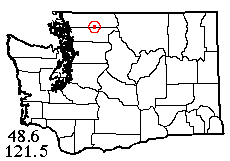 |
![]() 12 VIII 2017: Back in 2011, a field trip to the Anderson-Watson Trail (SE of Mt. Baker) found lots of snow on August 20! What better place to try for the last 2017 summer trip on the last day of a record-breaking dry spell? We (Fiona Rhodes, Jerry Austin and I) found no snow this year, but spiders were present! Our goal was 3/4 mile farther than the previous trip, on a sort of pass over a high ridge leading to Watson Lakes. We reached the site easily, and Fiona and I started tapping dead wood in the adjacent old growth forest. My goal was 50 specimens and 10 species, and I achieved it, while Fiona got 3 of the same and 2 that were different. With this nice head start, I did some sweeping where a boggy meadow had formed between west and east slopes. Here, I had some competition: a distinct hum was audible, caused by innumerable yellowjacket wasps foraging in the same meadow! All of us were lucky and escaped stingless, even though Fiona actually disturbed a nest up in the forest. Anyway, sweeping and luck produced 4 species the wasps had missed. Then all 3 of us beat conifer foliage, adding a further 7 species. Fiona had found one wolf spider, giving us 25 in all from the pass site. As with the Hope Lake hike, crab spiders were in short supply, but I did get one solitary Philodromus rufus!
12 VIII 2017: Back in 2011, a field trip to the Anderson-Watson Trail (SE of Mt. Baker) found lots of snow on August 20! What better place to try for the last 2017 summer trip on the last day of a record-breaking dry spell? We (Fiona Rhodes, Jerry Austin and I) found no snow this year, but spiders were present! Our goal was 3/4 mile farther than the previous trip, on a sort of pass over a high ridge leading to Watson Lakes. We reached the site easily, and Fiona and I started tapping dead wood in the adjacent old growth forest. My goal was 50 specimens and 10 species, and I achieved it, while Fiona got 3 of the same and 2 that were different. With this nice head start, I did some sweeping where a boggy meadow had formed between west and east slopes. Here, I had some competition: a distinct hum was audible, caused by innumerable yellowjacket wasps foraging in the same meadow! All of us were lucky and escaped stingless, even though Fiona actually disturbed a nest up in the forest. Anyway, sweeping and luck produced 4 species the wasps had missed. Then all 3 of us beat conifer foliage, adding a further 7 species. Fiona had found one wolf spider, giving us 25 in all from the pass site. As with the Hope Lake hike, crab spiders were in short supply, but I did get one solitary Philodromus rufus!
Now, late in the afternoon, weather was treating us kindly despite an iffy forecast; we'd only had one minute-long sprinkle of rain, and here comes Mr. Sun! I wrapped up the pass site by sifting conifer litter, which was productive of specimens but added no species. Then we hiked back down to a somewhat more flowery meadow at the junction of a trail to Anderson Lake. Here, Jerry found a much bigger boulder talus field, but like the one at the pass it produced only one spider. I swept the meadow and Fiona beat conifers and between us we added three more species, making 28 total for the day. Now clouds of black-flies were emerging, and all seemed to be attracted to the line where my hat met my forehead! We dragged Jerry away from his rocks and headed out past a beautiful dusk view of Mt. Baker, satisfied with a productive end-of-season trip.
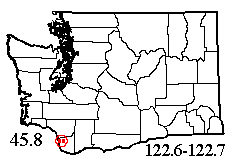 |
![]() 3 X 2017: For our first fall trip, I concocted an ambitious plan to complete partial samples from both sides of the freeway at La Center, in Clark County, far southern Washington. Laurel and I were lucky with traffic and arrived in good time at a county "Legacy Lands" tract at the end of a dead-end road on the placid East Fork Lewis River (barely a fork, it joins the Lewis about 3 miles above its mouth). There was just a hint of fall color in the trees. With 12 species already recorded, we knew this would be easy. Laurel added 4 species just from scanning the outside of a metal shed, then swept 2 more from grass along the river bank. I had a hard time finding any leaf litter, but the little I found added 4 species. Rich understory of a conifer grove added 4 nice ones, with one more from fir foliage and 2 from cedar: we now had 28 species from that area. Onward!
3 X 2017: For our first fall trip, I concocted an ambitious plan to complete partial samples from both sides of the freeway at La Center, in Clark County, far southern Washington. Laurel and I were lucky with traffic and arrived in good time at a county "Legacy Lands" tract at the end of a dead-end road on the placid East Fork Lewis River (barely a fork, it joins the Lewis about 3 miles above its mouth). There was just a hint of fall color in the trees. With 12 species already recorded, we knew this would be easy. Laurel added 4 species just from scanning the outside of a metal shed, then swept 2 more from grass along the river bank. I had a hard time finding any leaf litter, but the little I found added 4 species. Rich understory of a conifer grove added 4 nice ones, with one more from fir foliage and 2 from cedar: we now had 28 species from that area. Onward!
Across the freeway, I'd located a natural area in Allen Creek Canyon, owned by the Columbia Land Trust. A trailhead along shady Allen Canyon Road follows riparian meadows (unfortunately invaded by blackberry) to one end of Mud (a.k.a. Rosannah) Lake, a long narrow lake in the Columbia River floodplain. Forest on the slopes was dense and natural, with litter, moss and understory. Tally ho! Laurel started with 3 species from a chain link fence (including uncommon Arcuphantes arcuatulus); I swept 6 from the meadow, sifted 9 from maple litter and 3 more from moss, and the understory likewise yielded 9 species. Laurel hiked down to the lake while I was sifting, sweeping more species (notably Pachygnatha dorothea, an orbweaver that makes no web but hunts in marshland) from the near-lake meadow, and tried to get a Douglas-fir cone spider sample. Only 2 spiders in 50 cones — but one of them was Washington's first specimen of the extremely rare, minute palpless spider Gertschanapis shantzi, known from a few sites in California and Oregon!
We still weren't done finding cool stuff. A half-hour's tree-beating at the edges of an upland hayfield on the preserve added 3 more spider species and a harvestman. Walking back to the car, I swept some taller grass at the field's north edge, getting 2 juvenile Oxyopes lynx spiders. Every Oxyopes I've taken in Washington up to now appears to be O. scalaris. But these look very different; I suspect they are the southern species O. salticus, though adults will be needed to confirm. This would be only the latest of several spiders long known from Oregon, moving north along the I-5 corridor as the globe warms. In all, 36 species from the land trust property in a half day, making 42 from the area with prior records.
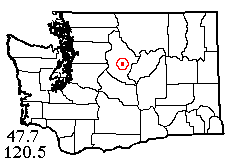 |
![]() 9 X 2017: While temperatures still permitted, we wanted to get in one fall trip to Ponderosa pine country. Immediately east of where we had collected (successfully) near Plain, Washington last year, all maps (and Google Earth) show a "Forest Road 6606" going miles up the South Fork of Beaver Creek. We reached the point where it branches off 6103, to find that the darn road isn't there any more — decommissioned at least 20 years ago and well overgrown! Fortunately the branching point was (just) inside our sampling area and had a nice variety of habitats. While Laurel brushwhacked up the former road, I swept roadside verge and beat fir trees, getting 17 species in around 2 hours. Laurel returned with 2 more conifer species, having found no pine trees; fortunately I had seen some a short distance up the side road, marked by a dazzling red vinemaple patch.
9 X 2017: While temperatures still permitted, we wanted to get in one fall trip to Ponderosa pine country. Immediately east of where we had collected (successfully) near Plain, Washington last year, all maps (and Google Earth) show a "Forest Road 6606" going miles up the South Fork of Beaver Creek. We reached the point where it branches off 6103, to find that the darn road isn't there any more — decommissioned at least 20 years ago and well overgrown! Fortunately the branching point was (just) inside our sampling area and had a nice variety of habitats. While Laurel brushwhacked up the former road, I swept roadside verge and beat fir trees, getting 17 species in around 2 hours. Laurel returned with 2 more conifer species, having found no pine trees; fortunately I had seen some a short distance up the side road, marked by a dazzling red vinemaple patch.
While Laurel sought pine cones, I sifted alder litter, getting an excellent 16-species sample. Vine maple litter added only one species, but it was a good one, rare crab spider Ozyptila yosemitica. Laurel only found 17 cones under my pine trees, but farther along she found a second grove that brought her up to a most satisfying total of 100 pine cones. And unlike last year, the cones were all open! Meanwhile I had added 1 more species from fallen bark. Our total was 31 species including two microspiders I don't immediately recognize. The day was sunny and cool, but not too cold for sifting: in fact, just right! For a wonder, there was little traffic going home over Stevens Pass, but Zeke's Drive-in had closed early so we couldn't take our customary burger break.
 |
![]() 15 X 2017: In 2012 and again in 2014, I climbed Sauk Mountain in Skagit County seeking a sample, getting only 19 species the first time and adding just one the second time! But this year I discovered that the main North Cascades Highway crosses a corner of the same gridspace not far east of Rockport, so it would be possible to "cheat" and complete the sample without climbing that mountain again! On this beautiful fall day, Laurel and I stopped at a gated (and overgrown) road into the tract, and collected mainly from roadside verge and the slope leading down to adjacent Skagit River. Not far from a working farm, the 11 species we took here included 6 introduced, but we did complete the sample; and Laurel took the first Washington specimen of introduced pirate spider Ero tuberculata! It was previously found in B.C.
15 X 2017: In 2012 and again in 2014, I climbed Sauk Mountain in Skagit County seeking a sample, getting only 19 species the first time and adding just one the second time! But this year I discovered that the main North Cascades Highway crosses a corner of the same gridspace not far east of Rockport, so it would be possible to "cheat" and complete the sample without climbing that mountain again! On this beautiful fall day, Laurel and I stopped at a gated (and overgrown) road into the tract, and collected mainly from roadside verge and the slope leading down to adjacent Skagit River. Not far from a working farm, the 11 species we took here included 6 introduced, but we did complete the sample; and Laurel took the first Washington specimen of introduced pirate spider Ero tuberculata! It was previously found in B.C.
Our main goal for the day was to collect along Bacon Creek Road, NE of Marblemount just outside the Park Service recreation area. Ron Austin was to come along to take pictures, but he failed to show up at our morning rendezvous. Turns out we missed him by at most 2 minutes. Anyhow, Laurel and I went 3 miles up the road (blocked at mile 4) and found habitats getting wetter and wetter, so we backtracked to the junction with a side road to Bacon Point. At that point, Laurel noticed a man from a parked car running after us. It was Ron Austin! He (and father Fred) had caught up with us and actually found us. They probably passed us when we were at the first site. Anyway, now we started collecting in earnest, beginning with conifer foliage that only netted me 7 species. Sweeping roadside verge, with Fred helping, added 4. The small dome weaver Neriene radiata was unusually common at this site, in all vegetation habitats. I got one adult Araneus from a web and then sifted 6 more species from maple litter, with 2 more from moss.
Meanwhile, Laurel clambered down to Bacon Creek, rather low in water at mid-day though it appeared more robust in the evening, and collected 2 good species under bluff-base stones, plus 3 more from foliage hanging down the bluff. Later we both worked the moist forest understory, each adding species. The site's best spider was rare linyphiid Drapetisca alteranda, which Laurel found on a road gate, making 30-31 for the site. Again, there was lots of fall color. We made it back to Concrete in plenty of time to dine at Cascade Burgers.
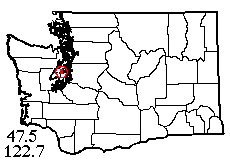 |
![]() 24 X 2017: For some time, I've been planning to collect in the Green Mountain area, an island of some 12 square miles of public forest with nearly 18 miles of trails, in the center of the Kitsap Peninsula. On this lovely fall day Laurel and I parked at Gold Creek Trailhead and headed up the creek, staying at creek level when the main trail turned up the mountain. This goes though some gorgeous habitats! Streamside riparian forest, then along a series of marshes maintained by beaver dams where the warm sun reached the trail. Unfortunately we could not get out into the marshes without dunking ourselves in the marginal ditches! We stopped just after a trail bridge over a tributary, where Laurel busied herself photographing and collecting spiders on the bridge. I sifted alder-cottonwood-fern litter and soon had 10 spider species. Sifting moss on trees added 8 more, so we were nearly there already! Both of us beat trailside understory, for an additional 7.
24 X 2017: For some time, I've been planning to collect in the Green Mountain area, an island of some 12 square miles of public forest with nearly 18 miles of trails, in the center of the Kitsap Peninsula. On this lovely fall day Laurel and I parked at Gold Creek Trailhead and headed up the creek, staying at creek level when the main trail turned up the mountain. This goes though some gorgeous habitats! Streamside riparian forest, then along a series of marshes maintained by beaver dams where the warm sun reached the trail. Unfortunately we could not get out into the marshes without dunking ourselves in the marginal ditches! We stopped just after a trail bridge over a tributary, where Laurel busied herself photographing and collecting spiders on the bridge. I sifted alder-cottonwood-fern litter and soon had 10 spider species. Sifting moss on trees added 8 more, so we were nearly there already! Both of us beat trailside understory, for an additional 7.
Only a narrow belt of woods separated our site from marsh to the south (a separate marsh from the long chain of them alongside the trail). But this, too, had an unleapable marginal ditch! While I sifted, Laurel strolled a little more than 1/8 mile up the trail and found a minor side trail leading uphill into a clearcut, where sweeping in the open added a further 8 species! Heading out, we made a side trip down a conspicuous unsigned trail to the south, ending at the short stream segment that connects the uppermost and lower marshes. Sweeping along this added another 4 species, including rare Bathyphantes malkini. Our total for the 7527 area, an excellent 42 species. Resuming the hike out, I spotted some open Douglas-fir cones that Laurel couldn't resist tapping. In 50 cones, she got one solitary juvenile spider, the day's one specimen of the non-native Enoplognatha ovata group.
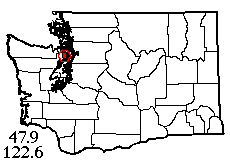 |
![]() 27 X 2017: My long-time Alaskan correspondent Susan Wise-Eagle was in Seattle on private business and wanted to go collecting! In her honor, I brought out one of the few remaining short-drive (if you take the ferry) trip plans, to Port Ludlow near the mouth of Hood Canal (Jefferson County side). We continued to have lovely Indian Summer weather. Our first stop was a town park/playground where Susan found 5 identifiable species on the restroom building while I beat 4 more from shore pine foliage. Then we headed for our main goal, little-known Forest Hill Cemetery (established about 1900) at the NW edge of town.
27 X 2017: My long-time Alaskan correspondent Susan Wise-Eagle was in Seattle on private business and wanted to go collecting! In her honor, I brought out one of the few remaining short-drive (if you take the ferry) trip plans, to Port Ludlow near the mouth of Hood Canal (Jefferson County side). We continued to have lovely Indian Summer weather. Our first stop was a town park/playground where Susan found 5 identifiable species on the restroom building while I beat 4 more from shore pine foliage. Then we headed for our main goal, little-known Forest Hill Cemetery (established about 1900) at the NW edge of town.
Easily accessible, the cemetery and adjacent forest provided a full spectrum of habitats. I was able to sift 11 spider species from about 3 bags of maple-conifer litter. Susan was discovering several spiders she hadn't seen in Alaska, such as Anyphaena aperta abundant on shrubs and Calymmaria suprema with its web in a deep bark fissure. A tall wall of salal at the edge of the grounds yielded 10 species to my beating net. Susan found 3 more under stones (natural stones, I mean!) and 2 from dead wood in the forest. Conifer foliage produced a few more. By 5 PM, when we had to leave, we'd seen only about 3 other humans in the cemetery. Susan hadn't quite finished sifting some moss from a concrete wall, so she did that in the Kingston ferry parking lot! We preserved our last specimens in the passenger area of the ferry, interesting some of the staff; 41 species for the day, completing a very highly productive October.
 |
![]() 7 XII 2017: Circumstances prevented any November collecting, but the first week of December brought dry weather and a temperature inversion with chilliness in Seattle giving way to warmer conditions in the foothills. Having interested Laurel in a trip to the hills NW of Mt. Rainier, we headed south by our usual route, only to run over some kind of box on the freeway that left something ominously dragging under the car. But a nice man at the Bonney Lake Jiffy Lube removed it; it turned out not to be even part of our car, but we didn't know that at the time. Bagging our original plan on rough back roads, we headed for an alternate site, past Carbonado to the Mowich Lake "highway", also unpaved but a smooth road — with unexpected patches of snow at our destination on the ridge above Evans Creek. Where we stopped, we were in the regrowth of an 11-year-old clearcut, and the most obvious habitat was conifer foliage. I managed to get 11 conifer spider species, hopping through soft-but-not-soggy snow patches; Laurel, sweeping winterized grass and shrubs, added 4 more.
7 XII 2017: Circumstances prevented any November collecting, but the first week of December brought dry weather and a temperature inversion with chilliness in Seattle giving way to warmer conditions in the foothills. Having interested Laurel in a trip to the hills NW of Mt. Rainier, we headed south by our usual route, only to run over some kind of box on the freeway that left something ominously dragging under the car. But a nice man at the Bonney Lake Jiffy Lube removed it; it turned out not to be even part of our car, but we didn't know that at the time. Bagging our original plan on rough back roads, we headed for an alternate site, past Carbonado to the Mowich Lake "highway", also unpaved but a smooth road — with unexpected patches of snow at our destination on the ridge above Evans Creek. Where we stopped, we were in the regrowth of an 11-year-old clearcut, and the most obvious habitat was conifer foliage. I managed to get 11 conifer spider species, hopping through soft-but-not-soggy snow patches; Laurel, sweeping winterized grass and shrubs, added 4 more.
Adjacent to our site was a taller regrowth stand in a 20+-year-old clearcut; this actually cast enough of a shadow on the road to prevent snowmelt, and I was hoping for understory. Indeed there was some, but it added no species. However, in this stand was a group of 3 alders that had dropped enough leaf litter for a bigger grove. One bag-full brought back to the car (so I could sift in the warm sun, almost shirtsleeve weather thanks to the inversion) got me 7 more spider species (and some good harvestmen), a surprisingly well-developed litter fauna for such a young forest. Encouraged, I brought back another bag, but by then air temperature had dropped enough that I got only 1/4 as many spiders. Laurel, meanwhile, found a bare Douglas-fir with wide-open cones on its branches while all those on the ground were solidly closed. Tapping these cones got her 4 species that pretty much duplicated the conifer foliage sample. A snag with loose bark was more fortunate, yielding adult Coriarachne brunneipes. Now, with the sun sinking toward early setting, we headed down the road to a somewhat lower site, hoping for different species on the vegetation; and indeed, we got 4 not taken at the first site even though it was getting so cold my hands took half an hour to warm up afterward. But 27 species for a short day in a semi-snowy landscape isn't bad!
That was the last blast of fall collecting, but stay tuned for 2018!
This page last updated 21 March, 2025